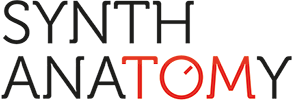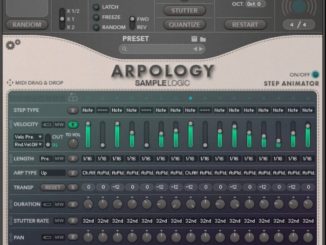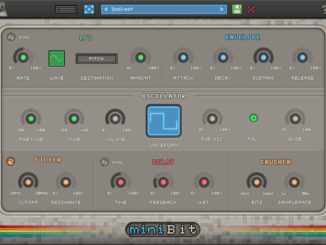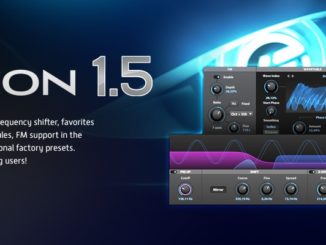UVI HX-Oddy takes the ARP Odyssey sound and embeds it in a new hybrid, virtual synth instrument for Falcon 3/UVI Workstation, full review!
The ARP Odyssey from 1972 is a legendary Synthesizer. A fat analog and a remarkable sync sound characterized the first duophonic synth. Behringer and Korg offer the “Ody” as a hardware clone/replica for the modern era. Accurate emulations are available from GForce Software (Oddity), among others.
In a new release, the UVI sample specialists also focus on this black-and-orange classic beauty. Instead of joining the lists of the other ARP Odyssey emulations, they have their unique twist for the “Ody” sound.

It is called HX-Oddy and continues the HX series, which started with the HX-20 virtual instrument in December 2023. An original virtual instrument based on the Korg MS-20 sound
They kindly gave me access to the HX-Oddy library in advance.
UVI HX-Oddy Review
I describe HX-Oddy as a virtual synth instrument because it’s a library instrument that runs in the flagship synth UVI Falcon 3 or the free Workstation plugin. It’s comparable to a library for Kontakt.
After your purchase, you can download the 3.53 GB via the UVI Portal app. Once done, you must register it via the “beloved” iLok software. All this worked flawlessly on my system. For testing purposes, I loaded the library into UVI Falcon 3. The data is located on an external hard drive.
HX-Oddy consists of four sections: main, edit, FX, and ARP. The main section, illustrated with a rendered realistic ARP Odyssey, offers an easy way to get to the library. You can choose one of the 250+ included patches and fine-tune them with the five pre-mapped macros.
Tone is a lowpass/highpass filter, phase, crush (bit-crusher), echo shifter, and cloud (lush reverb). There is a minimal amount of control, but you can effortlessly tweak the sounds in other inspiring directions. The depth is a click away.
Hybrid UVI HX-Oddy Engine
The engine is located behind the edit section. As a reminder, HX-ODDY is not an accurate emulation of the ARP Odyssey, and the library doesn’t want to be that either. It is its original instrument based on these iconic sounds.
Just like with the HX-20, UVI has opted for a hybrid dual layer engine. Part synthesis, part sample-based and Falcon 3 is the core of everything. The synthesis part uses two oscillators with wavetables newly crafted from the ARP Odyssey waveforms.
The oscillators offer classic subtractive synth functions such as control over the shape, pitch, octave, color, FM, etc. Besides PWM for each OSC, various other shapers (bend, formant, fuzzy…) allow you to enrich the wavetables with more harmonics for sounds behind the Odyssey.
The sample part uses multi-samples from the ARP Odyssey hardware Synthesizer, categorized into different instrument types (bass, lead, pads…). According to UVI, the sample pot has over 13000 hardware samples. That’s an impressive collection.
You can customize each sample-based instrument in detail with various controls: sample start, octave, color, pitch, unison, and more. In the dedicated mixer, both signal types come together and can be mixed individually. Plus, you can add a multi-color noise generator to it.
Modeled ARP Filter
Then, it goes into the filter. To keep it flexible, there are two filters: one for the synthesis and one for the sample-based instrument. You can use both, but you don’t have to. Looking behind the scenes in Falcon 3, you can see that the developers modeled the VCF 4023, the original filter of the Arp Odyssey MK1, for the library.
According to UVI, this filter is currently exclusively available in the HX-Oddy library, and they don’t know yet if it will be available to everyone via a Falcon update. Modulation is also onboard in the form of two envelopes, two multi-wave LFOs, and two customizable step modulators.

There is no built-in modulation matrix. However, you can easily map the modulators using the small dots next to the respective functions. Alternatively, press the larger dot on the right side of each function, and a dedicated window will open where you can assign the modulations.
This all works hassle-free. In addition to the modulators, you can also map velocity. However, an option to map aftertouch/polyAT is missing.
The mod engine is flexible and has many modulatable parameters, including the built-in effects in the third section. Drive, chorus, flanger, EQ, maximize, delay, and a lush reverb are available here to refine or finalize your sounds.

Arpeggiator/Phraser
Last but not least, in fourth place comes an arpeggiator/phrase. The latter is a type of sequencer. What’s neat about it is its flexibility. You can sequence the synthesis, sample, or both parts together.
It is also fully customizable in terms of speed, steps, octave, velocity, pitch, and more. Plus, you can set a different mode per step, ranging from classic to distinct chords. It is easy to use and fun to experiment with. Built-in preset patterns allow for instant changes.
The HX-Oddy engine offers a lot. Even if the name “library” suggests a rompler, you get a full-fledged Synthesizer with which you can also create custom Ody-flavored sounds from scratch.
How Does It Sound?
Technically explained, what does the new UVI HX-Oddy library sound like? Well, it does not sound like an accurate ARP Odyssey. That was not the goal, either. It sounds like a new instrument with the distinct characteristics of the Ody (fat, round, sync…).
The included 250+ sounds are fun and inspiring. They sit nicely and have a high-quality sound. You don’t hear any crackles or unwanted artifacts in the patches. It’s all at an excellent level.
The library’s benefit over the hardware is the polyphony, allowing you to make fat sounds like pads or strings with the full range. There are the classic bass and leads (examples: Bass Oddity, Old Bite, Big Leader…) but also unusual, wild stuff.
Since this engine goes further than the original in synthesis, some sounds also explore other sonic fields.
UVI HX-Oddy Review Conclusion
With the new HX-Oddy, UVI has created a beautiful, fat-sounding virtual synth instrument for its soft ecosystem. Even if it is not an authentic emulation of the ARP Odyssey, it shows what you can do with the sound of this classic.
It’s welcome that you can intervene in the sounds anytime and create new timbres without going too deep. This is perfect for musicians who want quick and inspiring results in software. Loaded into Falcon 3, you can go deeper anytime.
The included patches are particularly noteworthy. They are of high quality and provide instant inspiration. It’s a shame that there is no option to customize the aftertouch or to create layers or splits right out of the box. Falcon 3 users can do this, but not in the free Workstation.
In summary, HX-Oddy is a high-quality library with a colorful selection of fully customizable and instantly satisfying sounds.
Pro
- flexible engine (more than a rompler)
- sound quality
- patches
- user interface
Neutral
- after each patch change, the macros lose the MIDI CCs (not sure my fault or UVI Falcon)
- no NKS support
Contra
- no aftertouch modulation setting
- no layers or splits out of the box
UVI HX-Oddy is available now for a special introductory price of $49/49€ through July 22, 2024 (regularly $79/79€). It’s also part of the UVI SonicPass subscription for $24/24€ per month or $240/240€ per year.
It runs as a library in UVI Falcon 3 or in the free Workstation plugin as a VST, VST3, AU, and AAX plugin on macOS (native Apple Silicon + Intel) and Windows. An iLok software (up to 3 computers) or hardware stick is required for the authorization (up to 3 computers).
More information here: UVI







they keep flashing the phony hardware image because UI is so bad? i don’t get it, if software is soooo goooood why have the gimpy fake hardware images at all. insecure much?
they might just do it so you have something to get upset about 😉